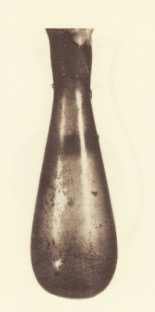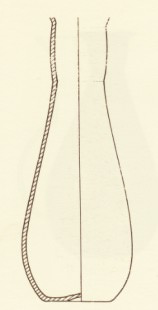Grave goods of Patriga (t. 80)
In the eastern cemetery area of Columbaris amongst the 157 tombs found there is the capuchin one no. 80 (fig. 1), located in sector IV, 2. That tomb held a young noble woman named Patriga. It contained carefully arranged grave goods including a fibula, a pin (fig. 2), a cup and an unguentarium.


The fibula was found at the height of the deceased person's collar bones as it was used to close the cloak she was wearing. It has a pearled edge, a band of small triangles and a central button-shaped umbo (fig. 3). The broach is silver and the tongue bronze. That item, datable VI-VII century, is the typical Roman-Byzantine clothing object and another three examples were found in Sardinia (fig. 4).



The burial gives us the chance to understand aspects of early medieval customs (see figs. 10-11) due to the presence under the nape of Patriga of the remains of some silver threads, perhaps from a precious fabric cushion placed under her head or, more probably, referable to a net used to support her hairstyle. Then in her hair she must have had a silver pin (figs. 5-6), found under her jaw. On the middle part of the pin you have the inscription Patriga / Femina / Honesta with a series of engraved decorative motives. From that praise, probably from her spouse, you can deduce what her name was (fig. 5). The item can be dated between the VI and VII century.


From the earth used to fill in the tomb, a cup in African terracotta sigillata D (end IV and V century; see fig. 7) and a glass unguentarium (III-IV A.D., see figs. 8-9). Glass unguentaria were used to contain perfumes and ointments to be used during the funerary rite. Various fragments were found in the eastern cemetery area (for the shapes see figs. 8-9). As for grave goods, we need to distinguish between the true funerary ones, considered both as an offering to the deceased (like the cup and the unguentarium) to accompany her to life in the afterlife, and what belonged to the person, like ornaments or clothing items revealing the person's social status (fibula and pin).





Bibliografia
- C. AMANTE SIMONI, I corredi altomedievali (II metà del VI-VII secolo), in C. AMANTE SIMONI, R. MARTORELLI, I corredi funerari e la suppellettile metallica. Cultura, Materiali e Fasi Storiche del Complesso Archeologico di Cornus. Primi risultati di una ricerca, in AA.VV., L'archeologia romana e altomedievale nell'Oristanese. Atti del Convegno di Cuglieri (22-23 giugno 1984) = Mediterraneo tardoantico e medievale, Scavi e ricerche, 3, Taranto 1986, pp. 171-177, catalogo nn. 153-154, pp. 187-189.
- C. AMANTE SIMONI, R. MARTORELLI, I corredi funerari e la suppellettile metallica. Cultura, Materiali e Fasi Storiche del Complesso Archeologico di Cornus. Primi risultati di una ricerca, in AA.VV., L'archeologia romana e altomedievale nell'Oristanese. Atti del Convegno di Cuglieri (22-23 giugno 1984) = Mediterraneo tardoantico e medievale, Scavi e ricerche, 3, Taranto 1986, pp. 161-189.
- G. BORGHETTI, D. STIAFFINI (a cura di), I vetri romani del Museo Archeologico Nazionale di Cagliari, Oristano 1994, pp. 176, 288.
- A. CARANDINI, S. TORTORELLA, Produzione D, in Atlante delle forme ceramiche, I. Ceramica fine romana nel bacino del Mediterraneo (medio e tardo impero), Supplemento dell’Enciclopedia dell’arte antica, Roma 1981, pp. 78-116.
- D. GANDOLFI, Sigillate e ceramiche da cucina africane, in D. GANDOLFI (a cura di), La ceramica e i materiali di età romana. Classi, produzioni, commerci e consumi, Bordighera 2005, pp. 195-232.
- A. M. GIUNTELLA, Sepoltura e rito: consuetudini e innovazioni, in AA. VV., Le sepolture in Sardegna dal IV al VII secolo. IV Convegno sull'archeologia tardoromana e medievale (Cuglieri 27-28 giugno 1987) = Mediterraneo tardoantico e medievale. Scavi e ricerche, 8, Oristano 1990, pp. 215-230.
- A. M. GIUNTELLA, Note su alcuni aspetti della ritualità funeraria nell’alto medioevo. Consuetudini e innovazioni, in G. P. BROGIOLO, G. WATAGHIN (a cura di), Sepolture tra IV e VIII secolo. 7° Seminario sul tardo antico e l’alto medioevo in Italia centro settentrionale (Gardone Riviera, 24-26 ottobre 1996) = Documenti di archeologia, 6, Mantova 1998, pp. 66-67.
- A. M. GIUNTELLA, Cornus I.1. L'area cimiteriale orientale = Mediterraneo tardoantico e medievale. Scavi e ricerche, 13. 1, Oristano 1999, pp. 147.
- J. W. HAYES, Late Roman Pottery, London 1972, pp. 13-14, 126.
- J. KAJANTO, The Latin Cognomina = Societas Scientiarum Fennica. Commentationes humanarum Litterarum, XXXVI, 2, Helsinki 1965, p. 313.
- R. MARTORELLI, I materiali metallici e gli oggetti di corredo, in A. M. GIUNTELLA (a cura di), Cornus I. 2. L'area cimiteriale orientale. I materiali = Mediterraneo tardoantico e medievale, 13. 2, Oristano 2000, pp. 23-50.
- L. PANI ERMINI, Recenti contributi dell’archeologia per la Sardegna paleocristiana e alto medievale, in Atti della Pontificia Accademia romana di archeologia. Rendiconti, LIII, LIV, 1980-1981, 1981-1982 (1984), pp. 221-245.
- L. PANI ERMINI, R. ZUCCA, L'età paleocristiana e altomedievale: la produzione artigianale e l'epigrafia, in V. SANTONI (a cura di), Il Museo Archeologico Nazionale di Cagliari, Sassari 1989, pp. 247-286.
- L. SALADINO, M. C. SOMMA, Terra sigillata africana D, in A. M. GIUNTELLA (a cura di), Cornus I. 2. L'area cimiteriale orientale. I materiali = Mediterraneo tardoantico e medievale, 13. 2, Oristano 2000, pp. 189-230.
- D. STIAFFINI, La suppellettile vitrea nelle aree cimiteriali in Sardegna: IV-VII secolo, in AA. VV., Le sepolture in Sardegna dal IV al VII secolo. IV Convegno sull'archeologia tardoromana e medievale (Cuglieri 27-28 giugno 1987) = Mediterraneo tardoantico e medievale. Scavi e ricerche, 8, Oristano 1990, pp. 243-256.
- D. STIAFFINI, I materiali vitrei, in A. M. GIUNTELLA (a cura di), Cornus I. 2. L'area cimiteriale orientale. I materiali = Mediterraneo tardoantico e medievale, 13. 2, Oristano 2000, pp. 107-131.
- J. WERNER, Bewaffnung und waffen beigabe in der Merovingerzeit, in Settimane CISAM, XV (Spoleto, 30 marzo-05 aprile 1967), Spoleto 1968, pp. 90-138.
- R. ZUCCA, Il primo periodo bizantino, in L. PANI ERMINI, R. ZUCCA, L'età paleocristiana e altomedievale: la produzione artigianale e l'epigrafia, in V. SANTONI (a cura di), Il Museo Archeologico Nazionale di Cagliari, Sassari 1989, pp. 271-283.

 VR
VR